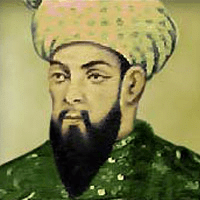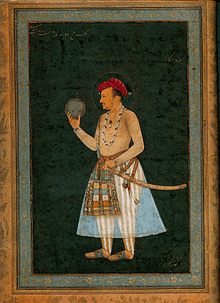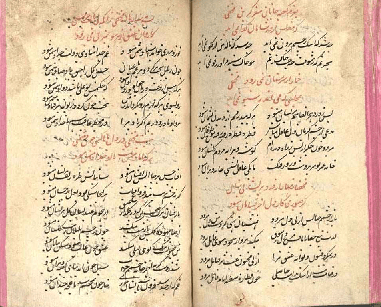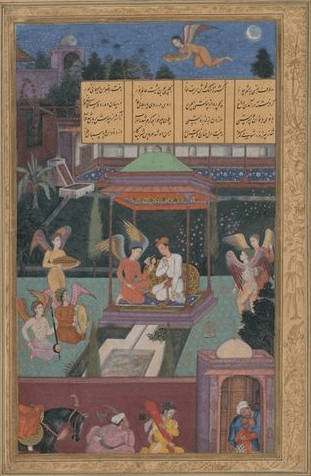UPSC Exam > UPSC Notes > Additional Study Material for UPSC > Literary Activities in Medieval India
Literary Activities in Medieval India | Additional Study Material for UPSC PDF Download
Literary Activities in Medieval period
- Zia-ud-din Barani : Authored Ta-rikh-i-Firuz Shahi. It was written in the time of Firuz Shah.
- Shams-i-Siraj Afif : A near contemporary of Barni. His work was also titled Tarikh-i-Firuz Shahi.
- Minhaj-ud-din Suraj : Authored Tabquat-i-Nasiri.
- Amir Khusrau : Author of Khazain-ul-Futtuh, Miftan-ul-Futuh, Tughluqnamah, Tarik-i-Alai, Laila Majnu, Aina Sikandari, Nur Siphir, and Hasht Bihist. He invented sitar. He was given the title of nayak.
- Hasan-un-Nizami : Wrote Taj-ul-Mahasir, full of praise for Qutb-ud-din.
- Minhaj-ud-din Siraj held a high post under Nasir-ud-din Mahmud, a younger son of Iltutmish who rose to the throne on 10 June, 1246.
 Minhaj-ud-din-siraj
Minhaj-ud-din-siraj - Amir Khusrau was born in 1252 at Patiali near Badaun, in west U.P. He was a contemporary of Balban, and was surnamed the Parrot of India.
- Sultan Firuz Shah Tughluq : Wrote his autobiographical memoir titled Fatuhat-i-Firuz Shahi.
- Ain-ul Mulk Multani : Wrote Munshat-i-Mahru. He had revolted in Awadh and was defeated in A.D. 1340-41 by Mohammad Tughluq.
- Yahiya bin Ahmad Sirhindi : Wrote Tarikh-i-Mubarak Shahi, in the time of Mubarak Shah Sayyid.
- Dala' il-i-Firuz Shahi : A persian verse, rendered from 300 volumes of Sanskrit books on various subjects, preserved in the temple of Jwalamukhi (Nagarkot), by a court-poet of Firuz Tughluq named A azz-ud-din Khalidkhani.
- A Bengali version of Mahabharata was made under the orders of Nasir-ud-din Nusrat Shah, the ruler of Bengal (1519-32).
- A Forgotten Empire : A history of Vijayanagar kingdom by Sewell.
- Krishna Deva Raya, the Vijayanagar ruler, wrote his magnum opus, Amuktamalyada, in Telugu. Peddana was his poet-laureate.
- Kalanirnaya : Written by Madhava Vidyaranya of vijayanagar between 1335 -60 it is a commentary on a Parasara Smiriti.
- Madanparijata : A smiriti work written for king Madanapala (1360-70) by Visvesvara.
- Chaitanya Charitramitra : By Krishnadas Kaviraj.
- Chandidas : The famous Vaishnava poet was born, probably towards the end of the fourteenth century, in the village of Nannur in the Birbhum district of Bengal, is still held in great esteem and his lyrics are known even to the common folk of Bengal.
- Vidyapati Thakur : A contemporary of Chandidas, though a native of Mithila, Vidyapati is regarded as a poet of Bengal and his memory is venerated by the people of this province.
- Raimukut Brihaspati Misra : A highly accomplished and famous writer of several works; patronised by Barbak Shah (C.A.D. 1486) of Jaunpur, himself a learned man.
- Maladhar Basu : Patronised by Barbak Shah; commenced writing his Sri Krishna-Vijaya in 1473; the Sultan conferred on him the title of Gunraj Khan.
- Krittivasa : Patronised by Barbak Shah of Jaunpur; his Bengali version of Ramayan has been regarded by some as the Bible of Bengal.
- Sultan Nusrat Shat (A.D. 1519-32) of Gaur had the Mahabharata translated into Bengali.
- About A.D. 1300 Parthasarathi Misra wrote several works on the Karma Mimamsa of which Sastra Dipika was studied most widely.
- The more important drama (in Sanskrit) of the time were Hammirmada-Mardana by Jay Singh Suri (A.D. 1219-1229), Pradyamna-abhyudaya by the Kerala prince Ravivarman, Pratap Rudra Kalyan by Vidyanath (A.D. 1300), Parvati Parinaya by Vamana bhatta Bana (A.D. 1400), Ganadasa Pratapvilas, celebrating the fight of a prince of Champaner against Muhammad II of Gujarat, by Gangadhar, and Vidagdha Madhava and the Lalita Madhava, written about A.D. 1532 by Rupa Goswami, minister of Husain Shah of Bengal.
- Amir Khusrau : Rose of fame during the reign of Balban; appointed the libarian of the imperial Library at Delhi by Jalal-ud-din Khalji, became court-poet of Ala-ud-din Khalji, enjoyed patronage of Ghiyas-ud-din Tughlaq died in 1324-1325.
- Shaikh Najm-ud-din Hasan : Popularly known as Hasan-i-Dihlavi; a poet of the Turko-Afghan period, whose fame was recognised outside India.
- Nizam-ud-din Auliya : Pious and learned scholar; flourished during the reign of Ala-ud-din Khalji.
- Maulana Muaiyyan-ud-din Umrani : The most notable of the literary man of the Tughluq period; wrote commentaries on the Husaini, Talkhis, and Miftan.
- Memoirs : By Babur (in his native Turki).Tr-anslated into Persian by Abdur Rahim Khan-i-Khanan in the time of Akbar in 1590; into English by Leyden and Erskine in 1826.
- Mutamid Khan authored Iqbalnama-i-Jahangiri. He was the court-chronicler at the time of Jahangir.
 Portrait of jahangir
Portrait of jahangir - Nuskha-i-Dikusha - by Bhimsen Burhanpuri.
- Adi Granth : By Guru Aroja Mal (1581-1606), the fifth Guru of the Sikhs.
- Daswen Padshah Ka Granth : by Guru Govind Singh (1675-1708).
- Dasabodh : By Ramdas Samarth, Guru of Shivaji. Ramdas was preceded in the preceding centuries by Eknath and Tukaram, followed by Vaman Pandit.
- Ghulam Husain wrote Siyar-ul-Mutkherin in the mid-eighteenth century.
- Alawal was a Muhammadan poet, who translated in the 17th century the Hindi poem Padmavat into Bengali.
- Jam-i-Jahan Numa : A Persian weekly of the early 19th century.
- Humayun-Namah : By Gulbadan Begam, the daughter of Babur.
- Tawarikh : Written by Sayyid Maqbar Ali, a minister of Babur.
- Chandi-mangal : By Madhavacharya, a Bengali poet of Triveni and a contemporary of Akbar.
- Tarikh-i-Alfi : By Mulla Daud.
- Muntakhab-ul-Tawarikh : By Badauni.
- Akbarnamah : By Faizi Sarhindi.
- Maasir-i-Rahimi : By Abdul patronage of Abdur Rahim Khan-i-Khanan.
- Mahabharat : It was compiled in other languages under the title of Razm-Namah.
- A.D. 1589 Badauni completed the translation of Ramayan.
- Haji Ibrahim Sarhindi translated into Persian the Atharva Veda.
- Faizi translated Lilavati, a work on Mathematics.
- Mukammal Khan Gujarati translated Tajak, a treatise on astronomy.
- Abdur Rahim Khan-i-Khanan translated into Persina the Waqat-i-Baburi.
- Maulana Shah Muhammad Shahabadi translated the History of Kashmir into Persinan.
- Ghizali : The most famous among the verse-writers, under the patronage of Akbar.
- Other prominent poets under the patronage of Akbar were Muhmmad Husain Naziri of Nishapur, who wrote ghazals of great merit, and Sayyid Jamaluddin Urfi of Shiraj, the most famous writer of Qasidas.
- Ghiyas Beg, Naqib Khan, Mu tamid Khan, Niamatullah and Abdul Haqq Dihlawi adorned the court of Jahanger.
- Maasir-i-Jahangiri and the Zubd-ut-Tawarikh were written during Jahangir's reign.
- Iqbalnamah-i-Jahangiri : Written by Mu' tamid Khan.
- Jahangir wrote his memoris titled Tuzuk-i-Jahangiri.
- Abdul Hamid Lahori wrote Padshah-namah (in Shah Jahan's time)
- Aminani Qazwini : Authored Padshahnamah.
- Inayat Khan : Wrote Shah Jahan Namah.
- Muhammad Salih : Authored Amal-i-Salih (in Shah Jahan's time)
- Works of Aurangzeb's time :
(i) Khafi Khan : Authored Muntakhab-ul- Lubab. It is the most famous history of this period. It had to be written in secrecy.
(ii) Mirza Muhammad Kazim : Wrote Alamgirnamah.
(iii) Muhammad Saqi : Wrote Ma asir-i-Alamgiri.
(iv) Sugan RaiKhatri : Wrote Khulasat-ul-Tawarikh
(v) Bhimsen : Wrote Nushka-i-Dilkhusha.
(vi) Ishwar Das : Wrote Fatuhat-i-Alamgiri.
- Religious literature of the Mughal period.
 Religious literature during Mughal period(i) Sur Sagar : By Surdas, adisciple of Vallab-hacharya and his son Bithal Nath. He was born at Agra.
Religious literature during Mughal period(i) Sur Sagar : By Surdas, adisciple of Vallab-hacharya and his son Bithal Nath. He was born at Agra.
(ii) Ras-panc- hadhyayi : By Nand Das.
(iii) Chaursi Vaishnav Ki Varata : By Vithal Nath (in prose)
Premavartika : By Raskhan. - In Bengal :
(i) Krishnadas Kaviraj (born in A.D. 1517in Burdwan) : He is the author of the most important biography of Chaita-nya, bearing the title of Chaitanyacha-ritramitra.
(ii) Brindavan Das(born in A.D. 1507) : Authored Chaitanya Bhagavata, which besides being a standard work on the life of Chaitanya Deva, is a store-house of information concerningthe Beng-ali society of his time.
(iii) Jayanand (born in A.D. 1513) :the author of Chaitan-ya Mangal, a biographical work giving some fresh in formationabout Cha-itanya Deva's life.
(iv) Trilochan Das(born in A.D. 1523): at Kowgram, a village situated thirty miles to the west of Burdwan); Authored Chaitanya Mangal
(v) NarahariChakravarti :authored Bhaktiratn-akar, a voluminous biography of Chaitanya Deva.
(vi) Kasiram Das:Translated Maha-bharata into Bengali.
(vii) Kavikankan Chandi :Written by Mukun-daram Chakravarti in Bengali. It enjoys to this day as much popularity in Bengal asthe famous book of Tulsidas in upper India.
It depicts a graphic picture of the social and economic conditions of the people of Ben- gal of his time, and it is for this that Prof. Cowell has described him as the "Crabbe of Bengal". Muhammad Husain of Kashmir
Muhammad Husain of Kashmir - Muhammad Husain of Kashmir was the most distinguished penman of Akbar's court. Hegot the title of Zarrinqalam (gold-pen)
(i)Sundar Srinagar : By Sundar.
Satsai : By Bihari Lal.Both were written in Shah Jahan's time - Zia Nakhabi(died in A.D. 1350) : He was the first totranslate into Persian Sanskrit stories. He translated Kok Shastra into Persian.
The document Literary Activities in Medieval India | Additional Study Material for UPSC is a part of the UPSC Course Additional Study Material for UPSC.
All you need of UPSC at this link: UPSC
|
21 videos|562 docs|160 tests
|
FAQs on Literary Activities in Medieval India - Additional Study Material for UPSC
| 1. What were the major literary activities in Medieval India? |  |
Ans. In Medieval India, there were several significant literary activities. The most prominent ones include the development of regional languages and literature, the growth of Persian and Arabic literature, and the composition of historical chronicles and biographies. Additionally, the Bhakti and Sufi movements also contributed to the literary landscape of the time.
| 2. Which regional languages witnessed significant literary development during Medieval India? |  |
Ans. Several regional languages witnessed significant literary development during Medieval India. These include Tamil, Kannada, Telugu, Malayalam, Bengali, Assamese, Gujarati, Marathi, and Hindi. Each of these languages had their own rich literary traditions with notable poets, playwrights, and scholars.
| 3. What was the role of Persian and Arabic literature in Medieval India? |  |
Ans. Persian and Arabic literature played a crucial role in Medieval India. Persian, being the court language of many Muslim rulers, led to the growth of Persian literature. It influenced various literary genres, including poetry, prose, and historical works. Arabic literature, mainly in the form of religious texts, was studied and translated by scholars and played a significant role in the dissemination of Islamic knowledge.
| 4. How did the Bhakti and Sufi movements contribute to literary activities in Medieval India? |  |
Ans. The Bhakti and Sufi movements had a profound impact on literary activities in Medieval India. The Bhakti movement, which emphasized devotion and love for a personal deity, gave rise to a rich tradition of devotional poetry in regional languages. Notable poets like Tulsidas, Kabir, and Mirabai composed devotional songs and hymns. Similarly, the Sufi movement, with its emphasis on spiritual love and union with the divine, led to the composition of Sufi poetry in Persian, Urdu, and other languages.
| 5. What were the types of historical literature produced during Medieval India? |  |
Ans. Medieval India witnessed the production of various types of historical literature. These include chronicles, which recorded the events and achievements of rulers and dynasties. Prominent examples include Rajatarangini by Kalhana and Tarikh-i-Firoz Shahi by Ziauddin Barani. Biographies, known as Tazkirahs, were also written to document the lives of saints, scholars, and nobles. One such famous Tazkirah is Tazkirat al-Awliya by Fariduddin Attar.
Related Searches






















